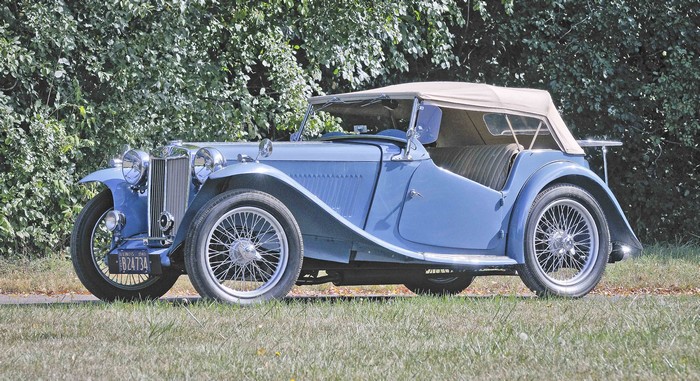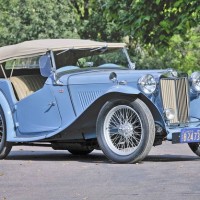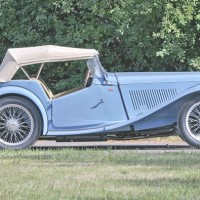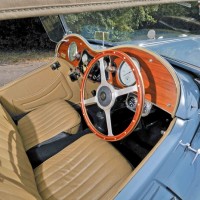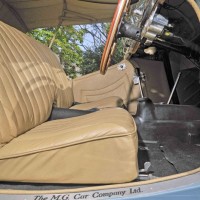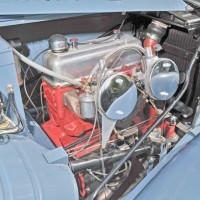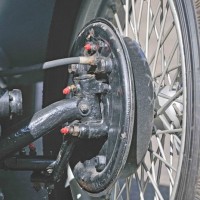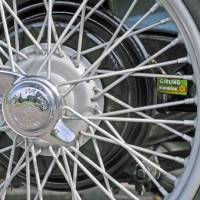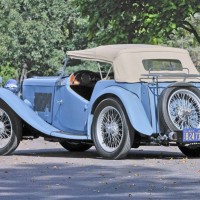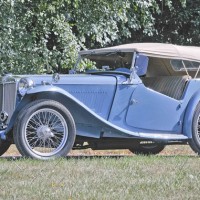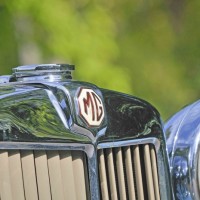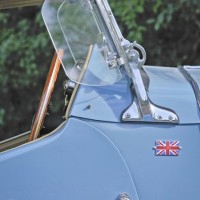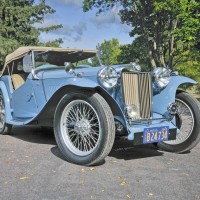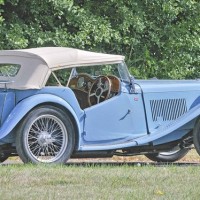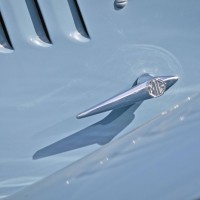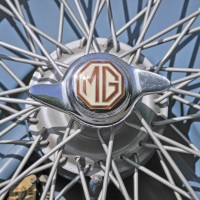• 4-cylinder engine
• Engine balanced
• 4-speed transmission
• Right-side driver
• 12-volt system
SCM Analysis
Detailing
| Vehicle: | 1949 MG TC |
| Number Produced: | 10,000 |
| Original List Price: | $2,238 |
| Tune Up Cost: | $350 |
| Website: | http://www.nemgtr.org |
This car, Lot F200, sold for $37,100, including buyer’s premium, at the Mecum auction in St. Charles, IL, on October 26, 2012.
No auction catalog was published, and the consignor provided the brief information above for the auction company website. However, the MG TC is a car that needs no introduction, although some description and analysis are in order.
The TC was an unlikely candidate for leader of a revolution and subsequent iconic status. There was nothing about it that would hint that it would spawn a tectonic shift in car culture, but it was on duty when societal forces aligned to create a perfect storm that changed the relationship between people and cars.
Made from 1945 to 1949, the TC was the first post-war MG, and third in the T series, replacing the TB, which replaced the TA. The lineage prior to that is not at all difficult to trace back to the MG’s origin in 1923. The family resemblance remained strong.
World War II interrupted MG production, but the TC carried on where the short-lived pre-war TB left off — the epitome of tradition unspoiled by progress. With a 4-cylinder, 1,250-cc overhead-valve engine that produced 54 horsepower, you almost needed an egg timer to measure the 0–60 mph time of well over 20 seconds — and that assumed no headwind. Top speed was around 75 mph.
In addition to the strong resemblance to MG cars made in the 1920s, the TC instrument panel looked like something out of a Jules Verne novel, and the over-caffeinated steering and twitchy handling reminded you of a circus bear riding a unicycle. However, whatever its faults, the timing was perfect.
A new world of small, fun cars
Post-war Great Britain was awash with American GIs, and as some Britons complained at the time, they were “overpaid, oversexed and over here.” And those Americans grew fond of the TC. The war had exposed an entire generation of Americans to international travel, and amid the elation over the war’s end — combined with time and money to spare — those GIs discovered the TC and the pleasure of motoring for its own sake.
So different was the TC from the average huge, heavy, lumbering American car, that it helped to create a whole new way for the middle class to look at cars — namely, as an object of entertainment, not just an appliance.
Adding to the uniqueness of these tiny, leaky novelties was the fact that they were all right-hand drive. By the standards of the time, it was downright exotic — a fashion statement, status symbol and entertainment center all rolled into one — and it led the British sports-car invasion of the lucrative U.S. market.
Easily corrected quibbles
This particular TC appears to have benefited from a thorough restoration. Its color combination of Clipper Blue with tan interior is original and refreshingly not red, and it suits the car exceptionally well.
Note also that the vertical grille slats are painted to match the interior, a stylish and correct feature. The body-panel fit is generally admirable.
Attention to detail throughout is apparently very good; however, there are several aftermarket items that may attract varying degrees of scorn from purists and deductions from concours judges.
For example, the steering wheel is not a correct original, and because a car’s steering wheel is its handshake, the original item is usually the best choice. The two instruments under the dash for water temperature and oil temperature, viewed through the steering wheel, are not original, but also not a bad idea and they are easily removed.
The dashboard appears to be the earlier type, as after 1947 they were vinyl covered with a tan/bronze-painted center section. However, it’s hard to resist the temptation to go with the lovely and vintage look of wood, so perhaps this bow to temptation may be overlooked.
The fender-mounted rear-view mirrors are not original, although they are useful and period-correct. Instead, there should be an oblong-shaped rear-view mirror on the driver’s side of the windscreen where the wind deflector is currently mounted. Speaking of which, the wind deflectors are also not original, but these are also useful and vintage aftermarket items.
The headlight shells appear original, but the inserts with the tripod arrangement are not. Also, the luggage carrier is not original and adds a distracting, cluttered look to the otherwise simple and elegant design.
Under the hood, the rocker cover and its securing nuts are not original, nor are the air cleaners. There should also be an alloy balance chamber that connects the carburetors. The engine color appears lighter than the original maroon. The rust forming on the exhaust manifold and around a freeze plug indicates that the restoration is not recent, but overall the car appears to have seen little use since.
The car has apparently been fitted with a Tompkins steering kit, an acceptable accessory. It is a bolt-on item and easily removable. It is the shiny metal top of the steering box and provides a roller bearing and provision for infinite adjustment.
Almost a top-flight TC
With some freshening, a few corrections and replacement of non-original items with correct originals, this could be a top-flight TC. However, it will never be capable of keeping up with modern traffic, and the novelty of the vintage handling, steering, braking and acceleration wears off quickly.
As a collector’s item, it is wonderful; as a car to drive, less so. With 10,000 produced, it will never qualify as rare, but its place in history makes it a worthy addition to any collection, although a significant increase in value is unlikely. Call it slightly well sold. ?
(Introductory description courtesy of Mecum Auctions.)
